ARKY 325 MIDTERM (Ancient Mesopotamia)
1/122
There's no tags or description
Looks like no tags are added yet.
Name | Mastery | Learn | Test | Matching | Spaced |
|---|
No study sessions yet.
123 Terms
Mesopotamia (from Greek) meaning
: the land between the two rivers.
Between the Tigris and the Euphrates river ( modern states of Iraqi, Syria, and southern Turkey)
Fertile Crescent
the area where Mesopotamia was built on
When and where did the first agriculture begin?
Happened in the Fertile Crescent about 12000 years ago (during the Neolithic, well before the rise of states
Domesticates from the fertile crescent include:
wheat, barley, dates, lentils, olives, oranges, onions, cattle, goats, sheep and pigs
Mesopotamia is a CULTURE AREA: (finish the sentence)
Shared cultural elements such as social practices, architectural and art styles, and ways of life
Mesopotamia civilisations include:
Assyria, Akkad, Sumer, Babylonia
Describe the Northern plain of Mesopotamia
Foothills of the Taurus and Zagreb mountains - enough rain in winter to grow crops without irrigation
Describe the Southern Plain in Mesopotamia:
(Akkad, and Sumer): Flat alluvial plain requires irrigation to grow crops (very little rainfall)
New Alluvium deposited by rivers each year =
Rich soils can produce enough food to feed dense populations with irrigation
Floodplain is a rich source of.....
Clay, palm trees, reeds, natural bitumen
What was Karl Wittfogels HYDRAULIC HYPOTHESIS?
Posits that irrigation led to the development of central authority
(1) of 5 points to Wittfogels HYDRAULIC HYPOTHESIS
1. Living in dry river valleys necessitates the formation of organized groups to manage irrigation and redistribute surplus production.
(2 and 3) of 5 points to Wittfogels HYDRAULIC HYPOTHESIS
2. People submit to this authority voluntarily, recognizing its role in managing resources.
3. Over time, this authority expands to control other areas, such as trade.
(4) of 5 points to Wittfogels HYDRAULIC HYPOTHESIS
4. The central authority controls water distribution, allowing it to divert water to its own fields, generating surplus for prestige goods, created by specialist craftspeople
(5) of 5 points to Wittfogels HYDRAULIC HYPOTHESIS
5. As a result, the authority becomes despotic, consolidating total power.
The ancient Sumerians are thought to be.....
ancestors of the Marsh Arabs, and indigenous peoples of Iraq
Scrub areas and marshlands in southern floodplain supported what?
Hunter-gatherer populations
What did farmers arrive with when they began to settle along the rivers on the floodplain?
1. Arrived with pottery and cooper technology
( they got their copper from Anatolia)
what are the different phases of development on the floodplains: 6500-4200 BC
Half, Hassuna, Samarra, and Ubaid
What does a phase mean?
distinct period of time characterized by distinct cultural traits, often represented by material culture (pottery, architectural and art styles) and subsistence practices, typically within a specific region
Phases generally develop in a time series but there is some overlap in time and space
Phases of development on the floodplains and the shift within houses
Shift from simple mudplain to farmers gradually moving into southern plain and initiating irrigation with increasing participation in trade
Halafian Phase (6000-5400 BCE)
- foothills/uplands of northern Iraq and Syria
- in the late 1980 it shows that the Halaf culture came from Indigenous groups in the area
What was the Halafian Phase recognized by?
1. Mudbrick THOLOI architecture
2. Finely painted pottery and art (amulets, figurines, stamp seals )
3. Rain-fed Agriculture (no irrigation)
Tholoi (key-shaped) mud-brick architecture are a defining characteristic of Halaf culture

Halaf culture also recognized by finely painted pottery, distinctive figurines, among other material culture
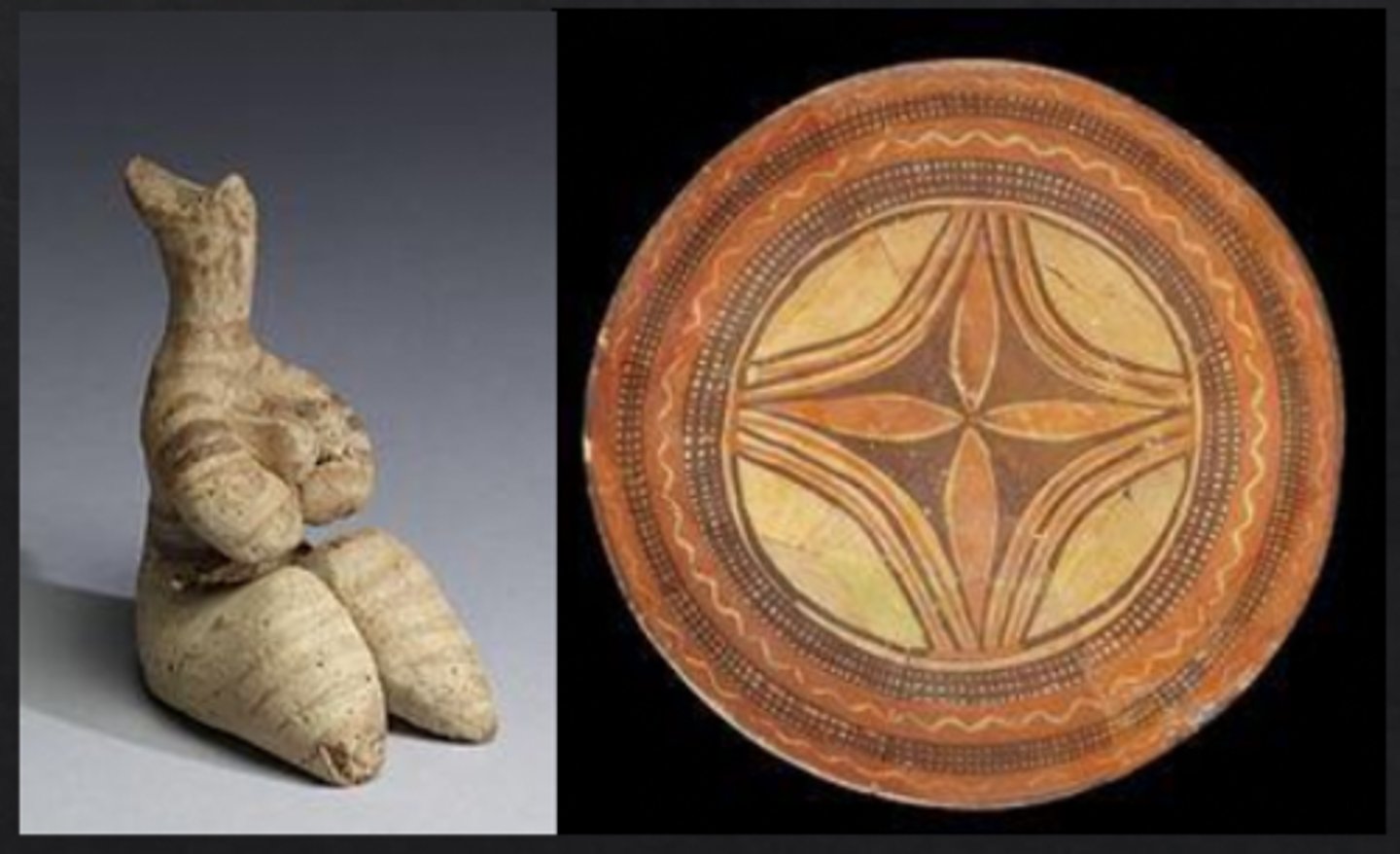
Hassuna Phase 6500-6000 BCE
- first farmers in the northern plane
- Moved from mountains into foothills of northern Mesopotamia and then gradually began to settle river valleys on southern plains
-Used some irrigation
Hassuna phase material Culture
- Mud-walled buildings with an open courtyard
- Hassuna style pottery (simpler than Halaf)
- Agriculture implements
- Domesticated animal bones
- Female figurines
Hassuna Phase house
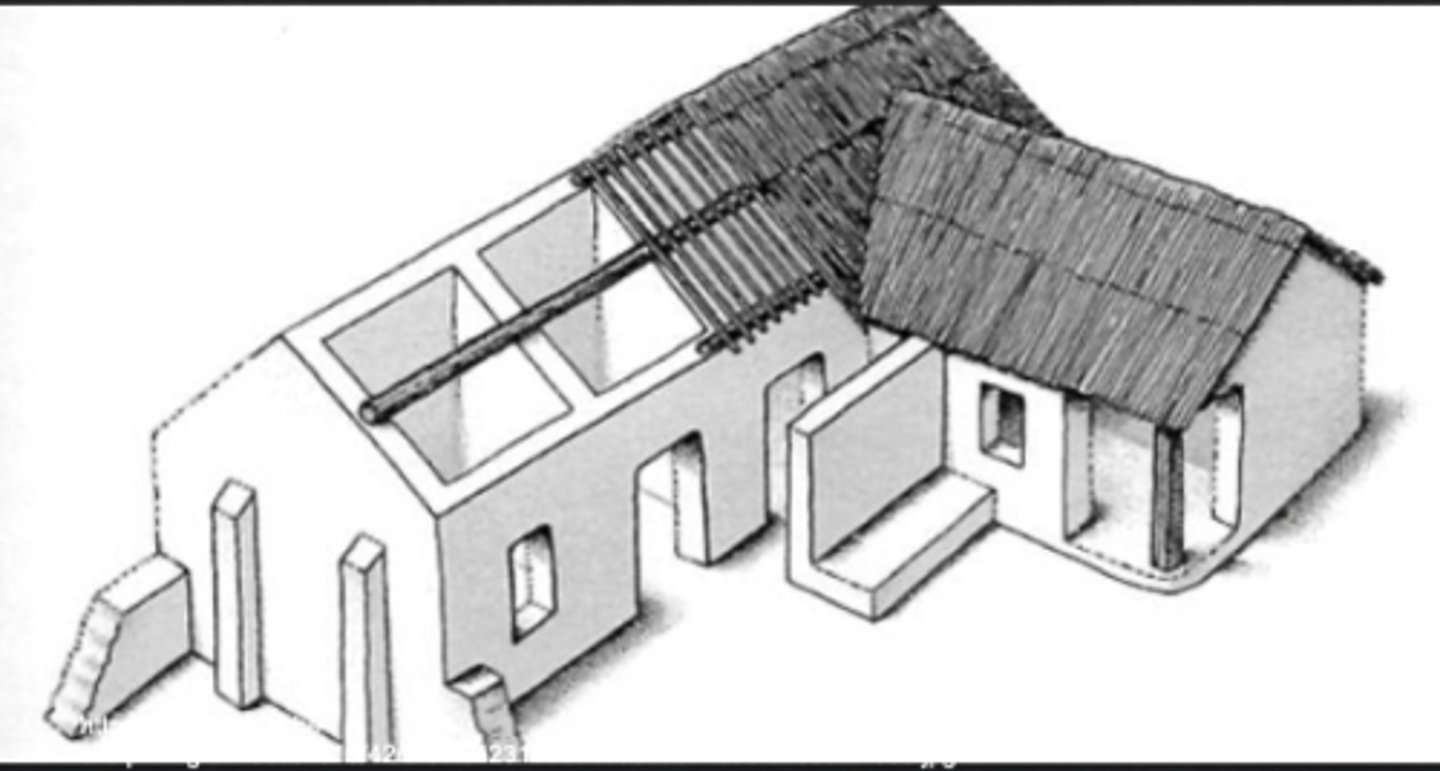
Hassuna Phase Pottery
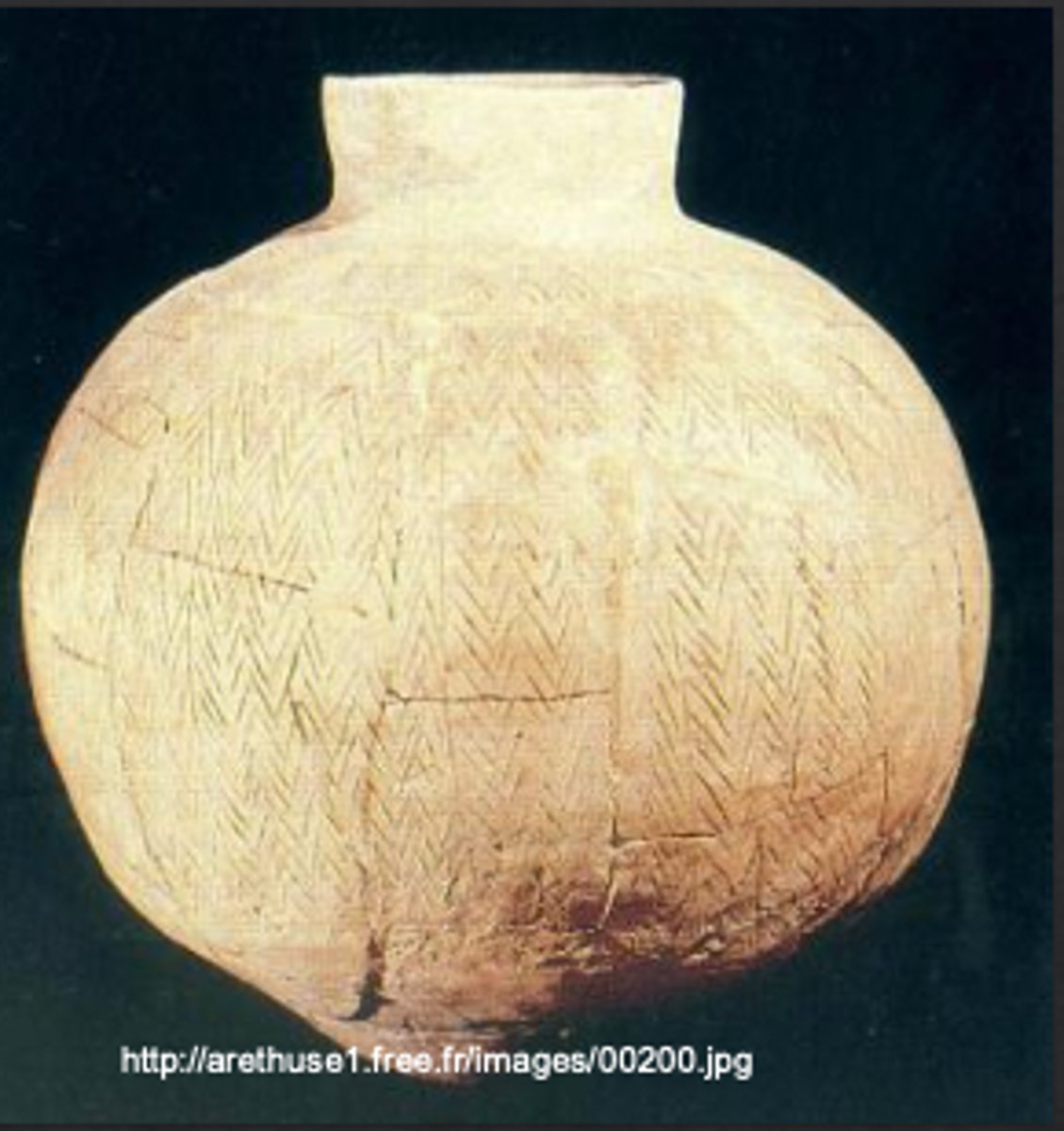
Samarra Phase 6500-5900 BCE (Time/ building)
- Overlaps with Hassuna in time and space
- Multi-roomed mud brick buildings surrounded by fortified wall, Shaped buildings possibly for grain and storage and rich burials 0 site of Tell es Sawn
Samarra Phase 6500-5900 (irrigation)
- First evidence for large scale canal irrigation at choga Mami site (6000 BC)
- Scale of irrigation implies organized labour and indicates presence of a prosperous, settled culture with a highly organized social structure.
Samarra Phase 6500-5900 (pottery)
- Samarra pottery style is first uniform style traded widely
- Imported goods include Cooper, carnelian, obsidian, turquoise
Samarra Phase 6500-5900
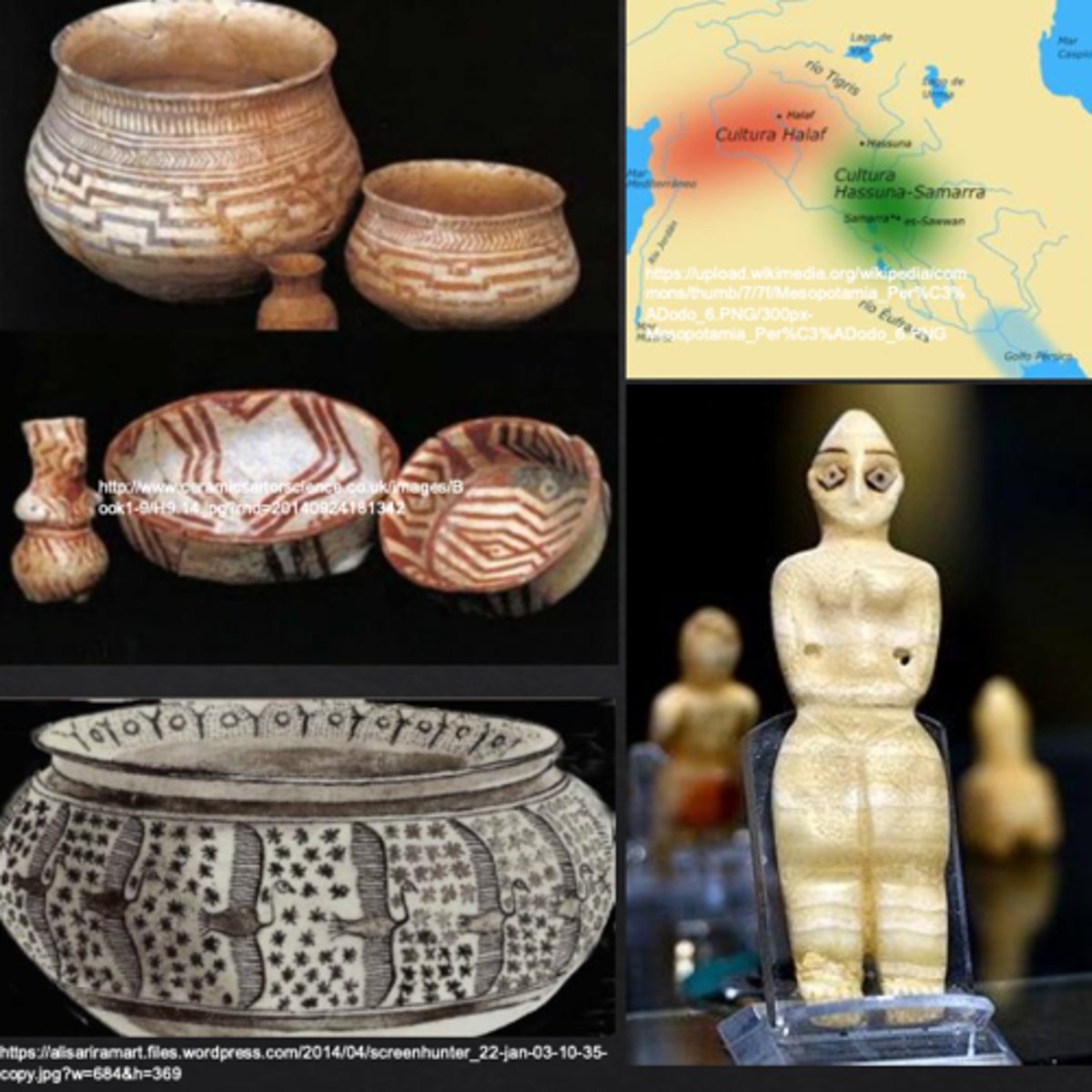
Ubaid Phase: 6000-4200 BCE
The Ubaid Phase or Period lays the foundation for Mesopotamian civilizations
- 6 sub-phases (0-5)
- First farmers settle the southern plain and establish villages with multi-room rectangular mud-brick houses
- Two-tiered settlement hierarchy ( Large sites of >10 ha and small villages of <1 ha)
- Villages had specialized craftspeople but most people were farmers.
-Beginning of temple institution and expansion of irrigation agriculture
Ubaid 0
- This is the initial phase, overlapping with Samarra culture
- The earliest known site in southern Mesopotamia, Tell el Oueili, dates to Ubaid 0, around 6000 BC
- The environment at this time was marshy and people exploited fish, birds, and other marsh resources (reeds)
Ubaid 0 pottery
Ubaid 0 pottery is the simplest of later Ubaid pottery, which is represented by black paint on buff wares
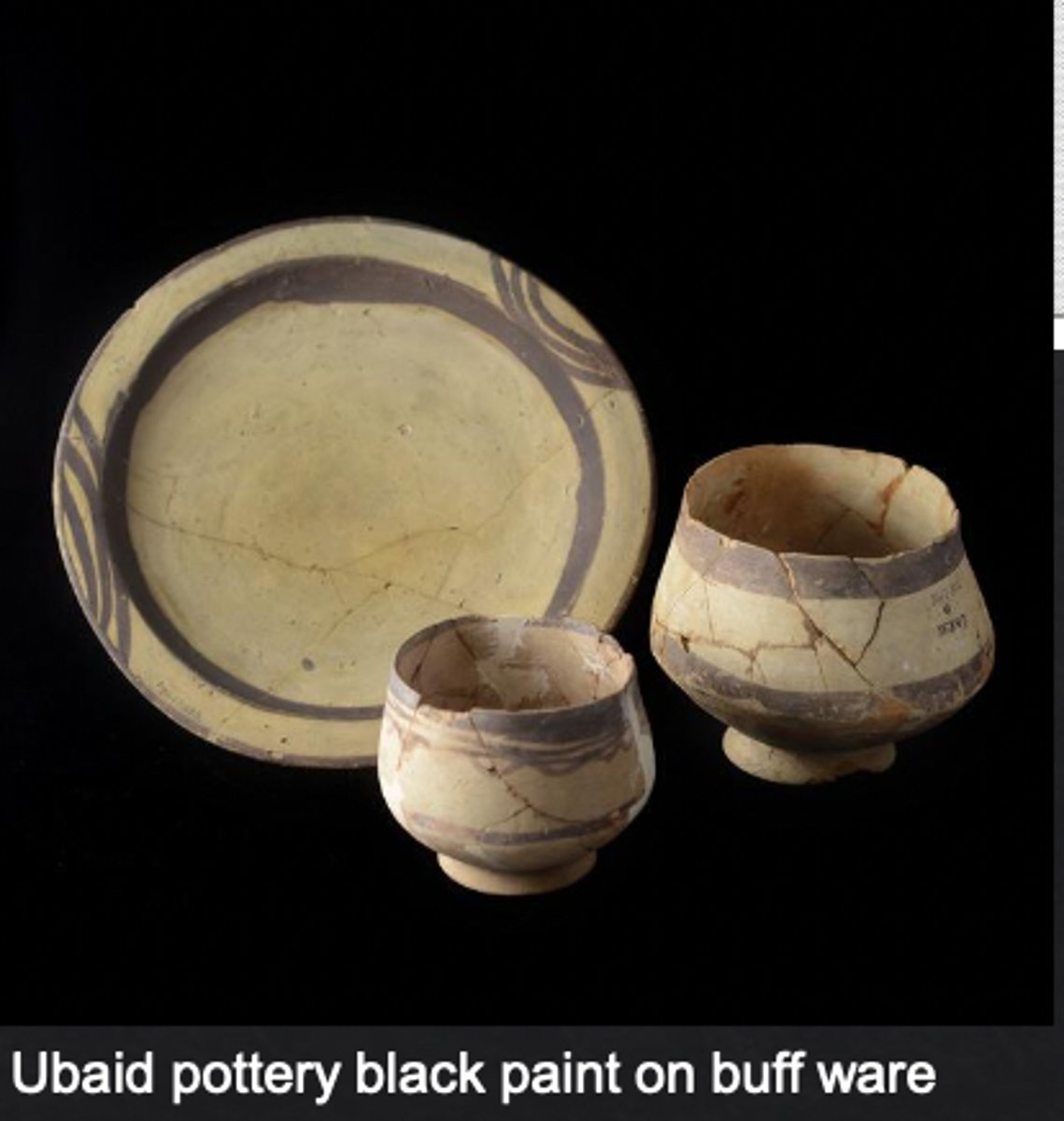
Ubaid 1
- around 4500 BC rapid urbanization developed, driven by irrigation and plough farming techniques
-Ubaid culture spreads rapidly from Eridu to the northern plain and around Persian Gulf coast to Oman (copper source)
- Two-tiered settlement hierarchy consisiting of Erode and smaller towns/villages
Ubaid 1 key technologies
Key technologies included the plough and irrigation systems, agricultural tools made of copper and pottery, and the use of sailing for trade and transport
Eridu (Ubaid 1)
considered one of the first urban settlements in human history, is representative of this transformation
- According to the Sumerian creation story, Eridu was first city, rising from the primordial sea
- Eridu, southwest of Nasiriyah, Iraq, is considered the world's first city and the mound depicted here may be the oldest temple on earth.
during Ubaid 1, when did temples become the center of Ubaid settlements?
5000-3000 BC
Who was Eridus patron God?
Ea (or Enki), the "lord of sweet waters that flow under the earth"
-Enki credited with founding Eridu (and civilization in general)
True or False? Eridu said to be the first of five cities where kings ruled for tens of thousands of years before they were wiped out by a "Great Flood"
True
What is the Eridus Temple dedicated to?
Enki
What type of platform was the Eridus Temple constructed on?
A large raised platform
How was the Eridus Temple built over time?
In many phases, each larger, higher, and with more buildings
What archaeological feature results from the construction of the Eridus Temple?
A sort of 'layer cake' as each construction event buried the earlier temple
What was located in the interior of the Eridus Temple?
An altar that faced the entryway and a pedestal used for offerings or sacrifices
What was constructed around the Eridus Temple?
Residences for priests/priestesses
Temples and what were a focus of Ubaid society
Temples and religion
Temple housed who?
city patron gods and the homes of religious authorities
Temples were not just religious institutions; they were also?
large land-holders and employers!
What was the influence of temple officials early in their development?
Temple officials held limited influence.
How did the power of temple authorities change as settlements expanded?
Temple authorities gained significant power.
What dual role did temples serve in communities?
Temples functioned as both religious and economic institutions.
What vital resource did temples control that contributed to their power?
Temples controlled water rights.
How did temples manage surplus production?
They used it to acquire traded prestige goods.
What effect did the acquisition of prestige goods have on temples?
It reinforced their status and influence.
What did Ubaid settlements produce?
Agricultural surplus and pottery
What materials did Ubaid settlements trade for in the uplands to the east?
Timber, copper, and precious stones
What did Ubaid settlements trade for from Anatolia?
Obsidian
How did Ubaid pottery spread?
It spread rapidly north and south
What was Ubaid society like?
Most settlements were self-sufficient in the needs of daily life (pottery, food production, cloth production, storage)
Traded for resources and goods they could not acquire locally or produce themselves
Some groups were wealthier than
others, but intra-settlement inequality is generally low
However, major differences in status and wealth between most of the population and priests/priestesses and temple authorities
Uruk revolution 4200-3100 BCE
- First cities and city states emerge
- Writing
- Wheeled vehicles
- Craft specialization
- Centralized religious and secular control
- Expansion of trading networks
- Clear evidence of social hierarchy
What are Tells?
What remains of Mesopotamian cities
- Tells are artificial mounds on the plain
What creates Tells
Created by the build-up and collapse of mud brick buildings and rubbish of city dwellers over time
- Many became stranded in desert as rivers changed their course
Uruk is
world's first true city and largest
in Uruk Period, 40,000- 80,000 people at
peak
Uruk Has
Top-level of a 4 tiered settlement hierarchy (cities, towns, villages, hamlets)
In Uruk what was each city considerd
Each city and its satellites are considered to be home of a major god in the Sumerian pantheon
-Uruk was home of Ishtar/Inanna, the goddess of love and war and ripening crops and the sky god Anu
Cities appear to have developed....
unplanned with temple/palaces at core that are surrounded by crowded narrow streets packed with rectangular houses of whitewashed mud bricks
Uruk is home to two temple complexes?
Anu Ziggurat with the White Temple and the Eanna Precinct
-I
initially two settlements, each with their own patron deities, but eventually merged into one large city
Eanna District
-comprised of courtyards, structures, terraces, and a temple platform, all dedicated to Goddess Inanna/Ishtar
-Earliest evidence of cuneiform writing comes from the Eanna District
What was required in large amounts to construct the Anu Ziggurat?
Labour (80,000 person days) and materials
What type of authority was necessary for the construction of the Anu Ziggurat?
Centralized authority
What does the size of the Anu Ziggurat reflect?
The power of authority
What was a consequence of the construction of the Anu Ziggurat regarding the populace?
Increasing separation of general populace and temple administration
What physical structures indicated the separation of the populace from temple administration around the Anu Ziggurat?
Walls around their residences and higher platforms
who was Uruks white temple dedicated to?
Dedicated to the primary god Anu (sky god)
what was the white temple built of
Built of limestone
- White Temple was decorated with cone mosaics (cones of different colours of clay)
what did the temples and ziggurats represent
-Possibly represent mountains or stairways for gods to descend to earth or to ascend to heaven
- Temple was place where deities lived
was there evidence of government during the Uruk period?
Yes
what does Ensi mean?
King is called "Ensi," translating to Lord of the Plowland
what did Ensi look like
male with long hair, beard and wearing a net skirt and headband
These individuals are also often depicted subduing enemies, taking prisoners
Role of Secular leaders
1. ruled by charismatic power or military
Secular leaders ruled by
prowess
2. Responsible for providing offerings to city's gods/goddesses
3. Rulers made offerings to the patron god to keep them happy
What did Mesopotamians believe?
believed god world was a mirror of living world
What role do priests play in relation to secular rulers?
Priests can usurp the power of secular rulers and hold them in check.
How did priests seek to predict the future?
They used dreams and readings of entrails from sacrificed animals.
What types of records did priests keep?
Records of sacrifices, divinations, and the events that followed.
What does the spatial seperation of palace from temple infer
infers separation of secular and religious power
What is the difference between Ubaid towns and Uruk period cities
Unlike large Ubaid towns, Uruk period cities are surrounded by walls up to 15m thick and built of kin fired mus brick (a symbol of power and wealth)
what did the excavation of Uruk Non-elite structures infer?
Rare excavation of Uruk non-elite structures at Abu Salabikh shows that people were living in extended family units (about 20 people) in large houses
In the late Uruk times what was happening with clan leaders
they were selling and purchasing land
4 key points of Uruk Economy
1. City and satellites linked together in a network of interdependece
2. every city is specialized in goods in order to trade with other cities
3. Craft production was under administrative control
4. Goods were moved by Donkey caravans and by boat on the rivers
The Warka mask, depicting goddess Ianna was made of marble and had lapis lazuli and shell eyes.
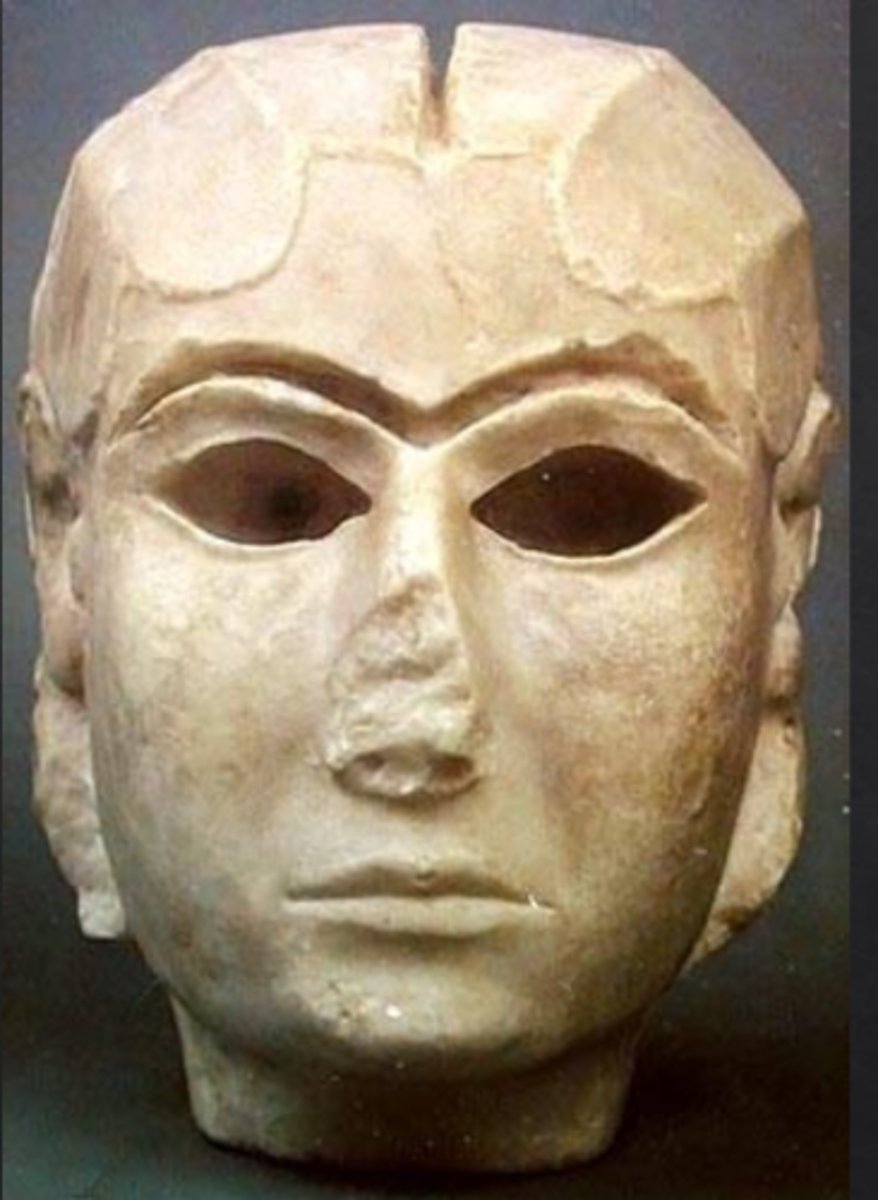
What was a significant outcome of long-distance exchange?
Huge expansion of long-distance trade to obtain materials for luxury items.
What luxury materials were obtained through long-distance trade?
Lapis lazuli, onyx, gold, carnelian, silver, alabaster, copper, etc.
What did Uruk trade for luxury goods?
Grain and some pottery.
What material was used by the earliest settlers in Mesopotamia?
Cooper
By what year was copper widespread in Mesopotamia?
3000 BC
Why did settlers have to trade for copper in Mesopotamia?
It does not occur naturally in the region.
What were some tools crafted from copper in Mesopotamia?
Agricultural tools, weapons, adornments, and figurines.